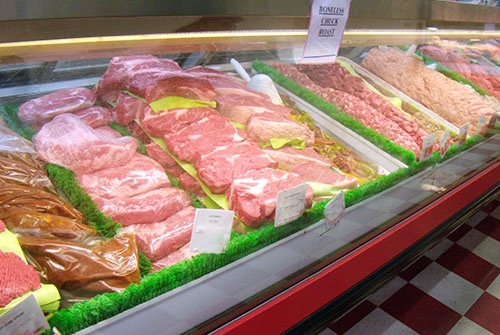Why Bagley Farms Meat Market Edwardsville IL Is the Best Choice for Quality Meats
Why Bagley Farms Meat Market Edwardsville IL Is the Best Choice for Quality Meats
Blog Article
Reveal the Art of the Butcher's Cut in a Modern Meat Market
In the ever-evolving landscape of contemporary meat markets, the butcher's cut has transcended its traditional origins, merging age-old workmanship with contemporary practices. What absolutely establishes the modern butcher apart is their capacity to create a deeper link in between consumers and the beginnings of their meat.
Evolution of Butchery Strategies
The evolution of butchery strategies shows an abundant tapestry of development and adjustment driven by developments in modern technology, modifications in customer demand, and a deeper understanding of meat scientific research. Historically, butchery was a craft passed down with generations, with methods developed over centuries to optimize return and flavor. The industrial revolution ushered in mechanization, changing typical practices and allowing large handling.
The mid-20th century saw butchery techniques even more fine-tuned by clinical understandings into muscle biology and meat aging, improving both tenderness and preference. Technologies like vacuum packaging and refrigeration extended product shelf-life, enabling butchers to branch out offerings and enhance top quality control. This duration additionally marked the increase of specific devices, such as band saws and meat slicers, which boosted accuracy and effectiveness in meat handling.

Digital systems now aid in monitoring pet provenance and enhancing cuts to meet details client preferences. In addition, a renewal in artisanal butchery has emerged, blending standard skills with modern knowledge to cater to consumers seeking honest and sustainable meat options.
Understanding Meat Cuts
Recognizing the ins and outs of meat cuts is crucial for both butchers and customers looking for top quality and worth. Each cut originates from a various part of the animal, imparting one-of-a-kind tastes, appearances, and cooking techniques - bagley farms meat market edwardsville il. Proficiency of these differences not just enhances culinary experiences yet likewise makes best use of the utility of each carcass. For butchers, specific cuts reflect ability and regard for the craft, ensuring very little waste and ideal yield.

Recognizing muscle mass structure is critical; muscular tissues utilized much more frequently by the pet often tend to be tougher and are best fit for sluggish cooking approaches, while less-used muscular tissues, like those located in the loin, are much more tender and ideal for cooking or roasting. Knowledge with these differences equips consumers to make enlightened selections, improving their cooking undertakings.
Picking High Quality Meat
Picking the appropriate meat includes more than simply selecting an aesthetically attractive item from the display screen. The art of selecting high quality meat calls for a critical eye and knowledge of certain features that represent quality and quality.
Second of all, consider the marbling, which refers to the white streaks of fat within the muscle. Proper marbling is an essential sign of inflammation and taste, as it thaws throughout food preparation, boosting the meat's juiciness. Remember, higher marbling frequently correlates with superior high quality cuts, such as USDA Prime.
Structure is an additional essential variable; meat should feel firm to the touch, not slimed or overly soft. Additionally, be mindful of the aroma. Fresh meat should have a Going Here tidy, neutral scent, free from any sour or off-putting smells.
Coupling Cuts With Food Preparation Techniques

On the other hand, harder cuts like brisket and chuck roast are abundant in collagen, which damages down into gelatin when prepared visit this site right here gradually. These cuts are perfect for braising or slow-moving roasting, allowing the meat to soften moved here in time and create deep, intricate flavors. In a similar way, cuts such as brief ribs and pork shoulder prosper with slow-cooking techniques, where expanded cooking times transform their durable structures into delicious dishes.
Lamb shanks and oxtail, which call for prolonged cooking to soften, are perfect candidates for cooking or slow simmering. These methods coax out rich, hearty flavors while maintaining moisture. By comprehending the special attributes of each cut, cooks and home cooks alike can elevate their culinary productions, ensuring each recipe is both pleasing and remarkable.
The Butcher's Duty Today
Browsing the progressing landscape of the modern meat market, the butcher's role today expands beyond plain preparation of cuts. Contemporary butchers are culinary craftsmens, educators, and supporters for lasting methods.
Along with crafting precise cuts, butchers currently involve directly with clients, supplying cooking guidance and customizing options to fit specific needs and preferences. Their proficiency in meat aging, marbling, and taste accounts empowers consumers to make educated choices, enhancing their culinary experiences. This tailored service exemplifies the butcher's progressing duty as a trusted advisor in the kitchen area.
In addition, butchers are pivotal in lessening waste, making use of entire pets to create diverse products such as sausages and stocks. This thorough strategy not only respects the animal however likewise straightens with modern sustainability objectives. By doing this, the modern butcher symbolizes both custom and advancement, adjusting to an ever-changing market while maintaining the artistry and integrity of their craft.
Conclusion
Mastery in understanding varied meat cuts and high quality indicators empowers butchers to give educated recommendations, straightening certain cuts with ideal cooking approaches. By recognizing historic methods while accepting modern needs, the butcher's function stays crucial in today's advanced meat market.
Report this page